#scenic murals
Explore tagged Tumblr posts
Text
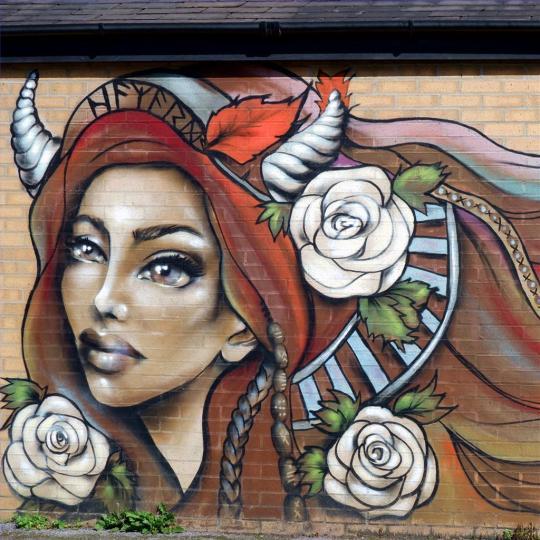
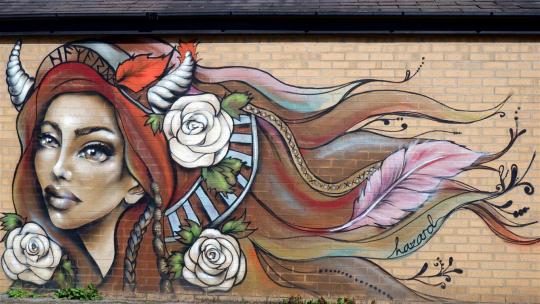
Roses in her hair.
Don't know the real name of this street art by Hazard, who was one of the top five female graffiti artists in the U.K. Came across by chance in York, England.
#Graffiti#Roses#Graffitiart#Fairycore#Fae#Faecore#Whimsigoth#Art#Street#Urban#Street Art#Mural#Public Art#Warmcore#Softcore#Cozy#Cozycore#Scenic#Aesthetic#Photography
48 notes
·
View notes
Text

"Stay Free" L’Aquila. Abruzzo , Italy.
#joe strummer#the clash#l'aquila#abruzzo#italy#italia#europe#italian photography#robertocastigliaphotography#scenery#street art#graffiti#scenic#street photography#urban art#wall art#arte#mural#wall painting#street artist
43 notes
·
View notes
Text
Where in the world: Blackheath, New South Wales, Australia
Founded: 1815 Population: Around 4,500 people
Known for: Location of Blue Mountains National Park and a stop on the major western railway







#australia#geography#travel#new south wales#NSW Australia#Blackheath australia#blackheath nsw#blackheath#raiload#railway#locomotive#train#footbridge#foliage#scenic#landscape#skylights#modern architecture#street art#mural#art mural#wall murals
0 notes
Text

In 1957 Barney and Francis began a project to beautify the plant that soon became a tourist attraction. They commissioned Les Grimes, a talented painter of scenic backgrounds for Hollywood movie sets, to create a farm mural on one wall. The result was so inspiring, Les continued to paint the mural until his passing in 1968. Arno Jordan continued the legacy by painting new murals and restoring Grimes' originals.
14 notes
·
View notes
Text
Today we visited the oldest monastery in Darjeeling, which also holds a section from the original Buddhist Book of the Dead!

The walk up to the monastery was also very scenic!

I was particularly impressed with the hospitality. A local guide greeted us at the end of the car road and escorted us for the ten minute walk to the gates, and even showed us a shortcut!

Once we reached the monastery, our escort handed us off to a new guide in training, who was very excited to show us around the murals of Buddha's life (after an introductory game of tug o' war).

All around excellent outing with A+ service from some very good boys.
#personal log#kiran travels#also to note we did not see a single human at the monastery#perhaps this particular monastery is run by good doggos
20 notes
·
View notes
Text
Theme: Lost in Translation; Two characters from different cultures/languages trying to communicate and understand each other (and sparks fly?)
1. An expat enrolls in a language class and struggles with the new language. The instructor, finding their efforts endearing, offers extra tutoring. Through their sessions filled with laughs and learning, they develop a deep mutual attraction.
2. During a cultural exchange program, an American participant and a Japanese participant are paired as roommates. Despite the language gap, they start teaching each other their native languages using charades and drawings, leading to an unexpected romantic connection.
3. At an international business conference, two delegates from different countries must collaborate on a presentation despite not sharing a common language. Their attempts to communicate through translation apps and gestures lead to a growing curiosity and attraction.
4. While backpacking through Europe, a Brazilian meets an Italian. They navigate their language differences with a pocket dictionary and lots of gesturing, discovering romantic sparks among the scenic views and cobblestone streets.
5. A visitor at a foreign food market struggles to order due to the language barrier. A local vendor finds their attempts charming and starts teaching them the local language through the names of dishes, sparking a flavorful and romantic connection.
6. Two language learners meet through an online exchange app. Their video calls are full of mispronunciations and laughter. As they help each other improve, they find themselves falling for each other, bridging their cultures and hearts.
7. Two artists from different countries collaborate on a mural. Despite limited verbal communication, they connect deeply through their art, expressing thoughts and emotions through paint and discovering a vibrant romantic connection.
8. While volunteering in a foreign country, a participant struggles with the local dialect. Another volunteer helps translate, and through their shared experiences and stories, they form a heartfelt connection that transcends language.
9. At an international literature festival, an English-speaking author works with a translator to present their book. As they discuss and flirt through the translation of text and footnotes, they find themselves drawn to each other, turning professional respect into romantic affection.
10. A tourist lost in a new city asks a local for directions. The local, intrigued by the tourist, offers to show them around. Their day together, filled with attempts to communicate and shared discoveries, turns into an unexpected first date.
#dialogue prompt#dialogue prompts#writblr#writeblr#writerblr#writing inspiration#writing prompt#writing prompts#prompt list#prompt themes
12 notes
·
View notes
Text

Artistic Adventures: Exploring America’s Most Creative Cities and Natural Wonders
For artists, the world is a canvas waiting to be explored. The United States, with its diverse landscapes and vibrant cities, offers a wealth of destinations that can inspire creativity and ignite the imagination. Whether you’re drawn to the energy of urban art scenes or the tranquility of natural wonders, this guide will take you on a journey through some of America’s most inspiring locations. From bustling metropolises to serene national parks, these destinations are sure to leave a lasting impression on your artistic soul.
1. New York City, New York: The Epicenter of Contemporary Art
New York City is a global hub for art, culture, and creativity. With its world-class museums, cutting-edge galleries, and vibrant street art scene, NYC is a must-visit destination for any artist.
Why New York City Inspires Artists
Iconic Museums: The Metropolitan Museum of Art, the Museum of Modern Art (MoMA), and the Guggenheim house some of the most influential works of art in history.
Street Art and Graffiti: Neighborhoods like Bushwick in Brooklyn and the Lower East Side in Manhattan are known for their dynamic street art, offering a raw and unfiltered form of artistic expression.
Cultural Diversity: NYC’s melting pot of cultures provides endless inspiration, from the colorful murals of Harlem to the avant-garde performances in the East Village.
What to Do in New York City
Spend a day at the Metropolitan Museum of Art, exploring its vast collection of art from around the world.
Take a walking tour of Bushwick’s street art to see works by local and international artists.
Attend a Broadway show or visit the Lincoln Center for a dose of performing arts.
2. Santa Fe, New Mexico: A Desert Oasis of Creativity
Santa Fe is a haven for artists, with its unique blend of Native American, Hispanic, and Anglo cultures. The city’s historic art scene, stunning landscapes, and vibrant galleries make it a top destination for creative minds.
Why Santa Fe Inspires Artists
Historic Art Markets: The Santa Fe Indian Market and Spanish Market are among the oldest and most prestigious art markets in the country.
Georgia O’Keeffe’s Legacy: The iconic artist’s connection to Santa Fe and the surrounding desert continues to inspire artists today.
Natural Beauty: The dramatic mesas, red rock formations, and expansive skies provide a stunning backdrop for artistic exploration.
What to Do in Santa Fe
Visit the Georgia O’Keeffe Museum to see her iconic works and learn about her life in New Mexico.
Explore Canyon Road, a historic street lined with over 100 galleries and studios.
Take a plein air painting class to capture the desert’s unique light and colors.
3. Asheville, North Carolina: A Creative Hub in the Blue Ridge Mountains
Nestled in the Blue Ridge Mountains, Asheville is a thriving arts community known for its craft breweries, historic architecture, and stunning natural surroundings.
Why Asheville Inspires Artists
Artisan Culture: The River Arts District, with its converted warehouses and studios, is a must-visit for anyone interested in contemporary art.
Natural Beauty: The Blue Ridge Parkway, with its sweeping mountain views, provides endless inspiration for landscape artists and photographers.
Historic Architecture: The Biltmore Estate, America’s largest home, is a masterpiece of design and craftsmanship.
What to Do in Asheville
Spend a day exploring the River Arts District, where you can watch artists at work and purchase unique pieces.
Take a scenic drive along the Blue Ridge Parkway, stopping at overlooks and hiking trails along the way.
Visit the Biltmore Estate to tour its grand rooms, gardens, and art collection.
4. San Francisco, California: A Bohemian Paradise
San Francisco has long been a haven for artists, writers, and free spirits. With its eclectic neighborhoods, iconic landmarks, and vibrant arts scene, the city offers endless inspiration.
Why San Francisco Inspires Artists
Cultural Diversity: The city’s diverse neighborhoods, from Chinatown to the Mission District, provide a rich tapestry of cultural influences.
Iconic Landmarks: The Golden Gate Bridge, Alcatraz Island, and the Painted Ladies are just a few of the iconic landmarks that have inspired countless artists.
Thriving Arts Scene: San Francisco is home to numerous galleries, theaters, and performance spaces, as well as the annual San Francisco Art Fair.
What to Do in San Francisco
Visit the San Francisco Museum of Modern Art (SFMOMA) to see works by contemporary artists.
Explore the murals in the Mission District, which reflect the neighborhood’s history and culture.
Take a ferry to Alcatraz Island to see the historic prison and its stunning views of the city.
5. Yosemite National Park, California: A Natural Masterpiece
Yosemite National Park is a place of unparalleled beauty, with its towering granite cliffs, cascading waterfalls, and ancient sequoia groves. For artists, Yosemite offers a chance to connect with nature and find inspiration in its grandeur.
Why Yosemite Inspires Artists
Iconic Landscapes: From El Capitan to Half Dome, Yosemite’s landmarks have been immortalized in countless works of art.
Changing Seasons: The park’s beauty transforms with the seasons, offering new inspiration throughout the year.
Tranquility: The serene meadows, crystal-clear streams, and starry skies provide a peaceful retreat for creative minds.
What to Do in Yosemite
Hike the Mist Trail to see Vernal and Nevada Falls, two of the park’s most stunning waterfalls.
Visit Glacier Point for a panoramic view of Yosemite Valley, Half Dome, and the High Sierra.
Explore the Mariposa Grove of Giant Sequoias to see some of the largest and oldest trees on Earth.
Tips for Traveling Artists
Document Your Journey: Keep a travel journal or sketchbook to capture your thoughts, ideas, and impressions.
Engage with Local Art: Attend workshops, gallery openings, or art fairs to meet fellow creatives and learn about the local art scene.
Pack Light but Smart: Bring essential art supplies, such as a sketchbook, portable easel, or camera, but avoid overpacking.
Embrace the Unexpected: Allow yourself to wander and explore, as some of the best inspiration comes from unexpected places.
Respect the Environment: Practice sustainable travel habits and leave no trace to preserve the beauty of the places you visit.
Conclusion
Artistic adventures are about more than just seeing new places—they’re about experiencing the world in a way that fuels your creativity and deepens your connection to your craft. From the bustling streets of New York City to the serene landscapes of Yosemite, America offers a wealth of destinations that can inspire artists of all disciplines.
As you embark on your journey, remember the words of the great artist Pablo Picasso: “Inspiration exists, but it has to find you working.” Let these destinations be your muse, and let your creativity flow from city streets to mountain peaks. Whether you’re capturing the vibrant energy of urban life or the tranquil beauty of nature, these artistic adventures will leave you with memories—and masterpieces—to last a lifetime.
2 notes
·
View notes
Text
Improve Your Area with Canvas Mountain Paintings and Wall Scenery Paintings.
Art can especially change places, bringing about a peaceful, beautiful atmosphere. The ability of canvas mountain paintings and wall painting sceneries to infuse your home with the tranquil appeal of nature makes them stand out among the many options available. These paintings add a blend of aesthetic appeal and peaceful spirit that makes them ideal for any space.
The Allure of Wall Painting Scenery
Your room's mood can be immediately improved with a wall painting scene that creates an immersive experience. Beautiful murals that depict a vast mountain range, a serene beach, or a verdant forest arouse feelings that bring you closer to nature.
VersatilityScenic wall paintings are appropriate for a variety of environments because they are available in a wide range of subjects and styles. There is something for every taste, ranging from contemporary abstract landscapes to classic representations of nature.
Peace and Motivation
Nature scenes have a calming effect on the psyche, promoting relaxation and lowering tension. A tranquil haven can be created in your house with a wall painting of a quiet lake or meadow.

Canvas Mountain Paintings: A Gateway to Majestic Landscapes
Mountains are a representation of power, steadiness, and perseverance. An enduring addition to your decor, a canvas mountain painting depicts the majesty of these natural treasures.
Dynamic Styles
Realistic mountain paintings take you right into the middle of nature painting with their fine details and vibrant hues.
Abstract Mountain Art: These paintings, which are ideal for modern environments, interpret the grandeur of mountains via striking hues and distinctive patterns.
Simple yet sophisticated, minimalist canvas art is perfect for contemporary homes since it emphasizes soft colors and crisp lines.
Visual Appeal and Significance
Your walls will seem more elegant with a canvas mountain artwork that encourages fortitude and resiliency. Its existence might serve as a daily reminder to pursue higher goals and overcome obstacles.
How to Choose and Place Your Painting
Room CompatibilityA vibrant wall painting of a landscape can invigorate a living room, while a simple canvas of a mountain looks good in a bedroom. Pick a painting that blends in with the space's color palette and furnishings.
Placement
To create a focal point, hang the picture on a wall that is noticeable over the bed, sofa, or fireplace.
To get the most impact, make sure it is at eye level.
LightingUse soft or directional lighting to highlight the painting, bringing out its details and enhancing its visual appeal.
Why Choose Scenic and Mountain Paintings?
Beauty that never goes out of style: These paintings look great in classic and contemporary settings.
They infuse your indoor areas with a peaceful and revitalizing sense of nature art.
Versatility: They accommodate different tastes and space configurations in various sizes and styles.
3 notes
·
View notes
Text
When you just want to write a cameo...
I'm writing this Transformers fic, fan continuity and all, and I'm 30-something chapter into it and haven't gotten anywhere near even starting the war yet.
But I like writing this arc in which Skywarp has a Seeker-seeking team and travels to different city-states and meets guest stars while they free all the Seekers from secret servility program malware left by Quintessons. Because, yanno all these city-states are gonna be destroyed later (probably, maybe?) so we should know what they were like so we understand the loss.
But sometimes it's the cameo-level guest star that causes me to get stuck.
I want Sunstreaker to make a cameo and I never write Sunstreaker, who, even pre-war, has some kind of baggage I'm sure. Also fans. Fandom has feelings about this character.
How do Sunstreaker?
I guess given the local in quaint The Village at Darkmount near the scenic Molten Pools natural attraction, mural painter?
(I think this place is like Deadloch but with lava and less serial killing.)
And we know Sideswipe is in Vos being local security for some reason. It's implied Sideswipe has a construct body like Clampdown whom he works for.
Does Sideswipe have a twin who wasn't snapped up to be put in a construct body and Sunstreaker was surplus to requirements and is one of these war-forged bots who wandered out of a spark field as a young-bot without a mentor in sight?
Always feeling like something is missing and has no idea who/what that is?
The murals are probably really dark.
Also Hoist and Tracks happen to be at this location at the same time, so it's like potential future Hollywood bots know each other from this time.
But how do Sunstreaker?
#transformers#sunstreaker#fanfic#writing#quintessons are to blame for construct forged divide in this continuity#they productized cybertronians with packaging and accessory paper for sale on other planets#there was a lot of wrath
12 notes
·
View notes
Text
The Must-Visit Destinations Germany
Germany, with its rich history, vibrant culture, and stunning landscapes, offers a diverse array of attractions that cater to every type of traveler. From the bustling streets of Berlin to the fairytale castles of Bavaria, Germany is a treasure trove waiting to be explored. Whether you're a history buff, a nature enthusiast, or an art lover, Germany has something special for you. Here are some of the best places to visit in this captivating country.

Berlin: The Heart of Germany
Berlin, the capital city, is a dynamic blend of the old and the new. Its historical significance is palpable as you explore iconic sites like the Brandenburg Gate, the Berlin Wall, and Checkpoint Charlie. The city is also a hub of modern art, culture, and nightlife. The East Side Gallery, a preserved section of the Berlin Wall covered in murals, and the Museum Island, a UNESCO World Heritage site, are must-see attractions. Berlin's diverse neighborhoods, each with its unique vibe, offer endless opportunities for exploration.
Munich: Bavarian Charm and Oktoberfest
Munich, the capital of Bavaria, is renowned for its picturesque architecture, world-famous beer gardens, and vibrant cultural scene. Marienplatz, the central square, is the perfect starting point to explore the city's historic buildings, including the stunning New Town Hall. Munich is also home to the legendary Oktoberfest, the world's largest beer festival, which attracts millions of visitors each year. Don't miss a visit to the Nymphenburg Palace and the English Garden, one of the largest urban parks in the world.
Neuschwanstein Castle: A Fairytale Come to Life
Nestled in the Bavarian Alps, Neuschwanstein Castle is straight out of a storybook. Commissioned by King Ludwig II, this 19th-century Romanesque Revival palace served as the inspiration for Disney's Sleeping Beauty Castle. The castle's picturesque setting, surrounded by lush forests and towering mountains, makes it one of the most photographed sites in Germany. Guided tours offer a glimpse into the opulent interiors and the fascinating history of Ludwig II's dreamlike creation.
The Romantic Road: A Scenic Journey
The Romantic Road is a picturesque route that winds through some of Germany's most charming towns and villages. Starting in Würzburg and ending in Füssen, this scenic drive takes you through medieval towns, vineyards, and castles. Highlights include the walled town of Rothenburg ob der Tauber, known for its well-preserved medieval architecture, and the baroque city of Würzburg, with its impressive Residenz Palace. The journey culminates at Neuschwanstein Castle, providing a perfect end to this enchanting road trip.
The Black Forest: Nature's Wonderland
The Black Forest, or Schwarzwald, is a region of dense forests, rolling hills, and quaint villages. Famous for its cuckoo clocks, thermal spas, and scenic beauty, the Black Forest is a haven for outdoor enthusiasts. Hiking, cycling, and skiing are popular activities in this area. The town of Baden-Baden, with its luxurious spas and casino, offers a touch of elegance, while Triberg is home to Germany's highest waterfalls and the Black Forest Museum, which showcases the region's rich cultural heritage.
Hamburg: The Gateway to the World
Hamburg, Germany's second-largest city, is a bustling port city with a unique maritime charm. The historic Speicherstadt, the world's largest warehouse district, and the modern HafenCity, with its striking Elbphilharmonie concert hall, showcase Hamburg's blend of old and new. Take a stroll along the Reeperbahn, known for its nightlife and entertainment, or relax at the serene Alster Lakes. Hamburg's rich musical heritage is evident in its numerous theaters, live music venues, and the Beatles' early performance venues.
Conclusion
Germany's diverse landscapes, rich history, and vibrant culture make it a destination that promises unforgettable experiences. Whether you're exploring the historic streets of Berlin, sipping beer in a Munich garden, or marveling at the fairytale beauty of Neuschwanstein Castle, each destination offers a unique glimpse into the heart and soul of Germany. Pack your bags and embark on an adventure that will leave you with memories to cherish for a lifetime.
2 notes
·
View notes
Text

Georgina Klitgaard, View of Poughkeepsie in 1840 (mural study, Poughkeepsie, New York Post Office), ca. 1940, oil on canvas, 10 1⁄8 x 36 1⁄8 in. (25.6 x 91.6 cm.), Smithsonian American Art Museum, Transfer from the U.S. Department of the Interior, National Park Service, 1965.18.55


Top Left: © Peter A. Juley & Son Collection, Smithsonian American Art Museum J0022187 | top right: c. 1920
#bornonthisday Georgina Klitgaard (née Berrian; July 3, 1893 – January 12, 1977) was an American artist. Klitgaard was known for panoramic landscape paintings of scenic New York from a bird's-eye view perspective. Via Wikipedia
Bottom: Georgina Klitgaard, Winter Afternoon, 1934, oil on canvas, 18 1⁄8 x 22 1⁄8 in. (46.1 x 56.1 cm), Smithsonian American Art Museum, Museum acquisition, 1969.194

2 notes
·
View notes
Text
Miami, Florida: Where Sunsets and Skyscrapers Meet

Miami, Florida, a vibrant metropolis nestled along the southeastern coast of the United States, is a city of unparalleled allure. From its breathtaking sunsets to its towering skyscrapers, Miami offers a unique blend of natural beauty and urban sophistication. In this article, we delve into the captivating essence of Miami, exploring its diverse attractions, cultural richness, and the dynamic interplay between its natural landscape and architectural marvels.
Sunsets Over the Magic City:
Miami is renowned for its mesmerizing sunsets that paint the sky with hues of fiery orange, soft pink, and golden yellow. Whether you're strolling along the sandy shores of South Beach or gazing out from a waterfront terrace, each sunset in Miami is a spectacle to behold. The city's coastal location provides the perfect vantage point to witness nature's masterpiece unfold against the backdrop of the glittering ocean waters.
Skyscrapers That Define the Skyline:
Miami's skyline is a testament to its modernity and progress, adorned with gleaming skyscrapers that punctuate the horizon. From the iconic silhouette of the Freedom Tower to the sleek lines of the Brickell City Centre, these architectural marvels stand as symbols of Miami's status as a global city. The juxtaposition of glass and steel against the azure sky creates a captivating visual panorama that captivates residents and visitors alike.
Cultural Fusion and Diversity:
Miami's cultural tapestry is as diverse as its population, reflecting a vibrant fusion of influences from around the world. From the colorful murals of Wynwood to the historic neighborhoods of Little Havana and Little Haiti, each corner of the city tells a unique story. Art galleries, museums, and performance venues abound, offering a rich tapestry of cultural experiences that celebrate Miami's multicultural identity.
Outdoor Oasis:
Beyond its urban landscape, Miami boasts an abundance of outdoor recreational opportunities that beckon adventurers and nature enthusiasts. The city's lush parks, scenic waterfronts, and pristine beaches provide endless opportunities for relaxation and adventure. Whether it's paddleboarding along Biscayne Bay, exploring the Everglades National Park, or simply basking in the sun at one of Miami's famed beaches, outdoor enthusiasts will find no shortage of activities to indulge in.
Culinary Delights:
Miami's culinary scene is a melting pot of flavors, reflecting the diverse heritage of its residents. From sizzling Cuban cuisine to innovative farm-to-table fare, the city offers a gastronomic journey like no other. Food enthusiasts can explore a tantalizing array of eateries, from upscale restaurants helmed by celebrity chefs to hidden gems tucked away in vibrant neighborhoods. Whether you crave authentic Latin American flavors, fresh seafood delicacies, or international fusion cuisine, Miami's dining scene promises to delight the palate.
Conclusion:
In Miami, Florida, the convergence of sunsets and skyscrapers creates an enchanting tapestry of beauty and wonder. From its stunning natural landscapes to its iconic architectural landmarks, the city offers a captivating blend of urban sophistication and tropical allure. Whether you're drawn to its vibrant cultural scene, outdoor adventures, or culinary delights, Miami beckons with endless possibilities, inviting you to experience the magic of a city where sunsets and skyscrapers meet in perfect harmony.
2 notes
·
View notes
Photo

"Stay Free" L’Aquila. Abruzzo , Italy.
#joe strummer#the clash#l'aquila#abruzzo#italy#italia#europe#italian photography#robertocastigliaphotography#scenery#street art#graffiti#scenic#street photography#urban art#wall art#arte#mural#wall painting#street artist
10 notes
·
View notes
Text
Driving around random places in Germany, like, the smallest who-cares towns and villages, reveals its massive history and how these region was so important and culturally richest in Europe. But tall highs mean deep lows sometimes I guess. We stopped at Deggendorf recently on our autobahn trip for the night - normally we choose some scenic city and also look around, but weather was bad - so anyway here's that sob of a town, some tiny old town center, but otherwise a 30k population dustbin. When quickly walking around - really nice and busy market with lotsa social life on weekdays as well which I always admire here - as the only attraction is the standard german unit of one medieval town hall and one old church, both rather nice and somewhat reconstructed since the town was mostly leveled during WWII (also a standard german unit of history).
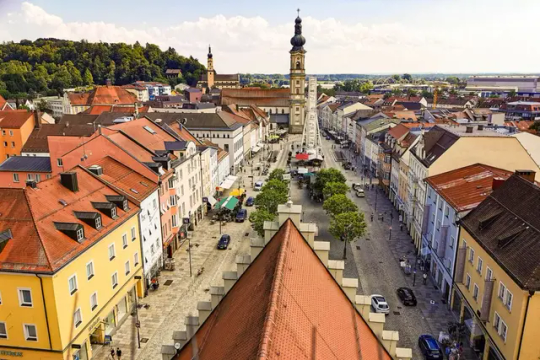
Kind of sad to see murals from the 50s on a 14th century church, in place of probably much grander artworks.

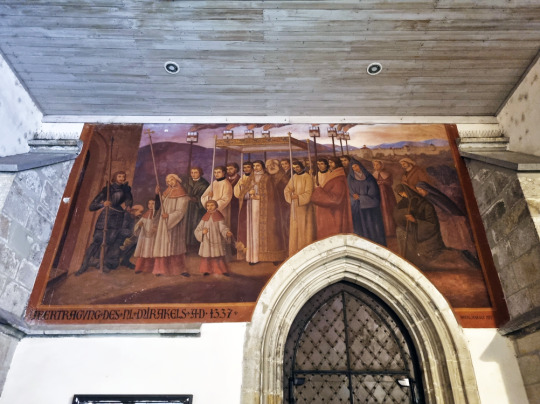
But there is a small tablet hanging on the side.
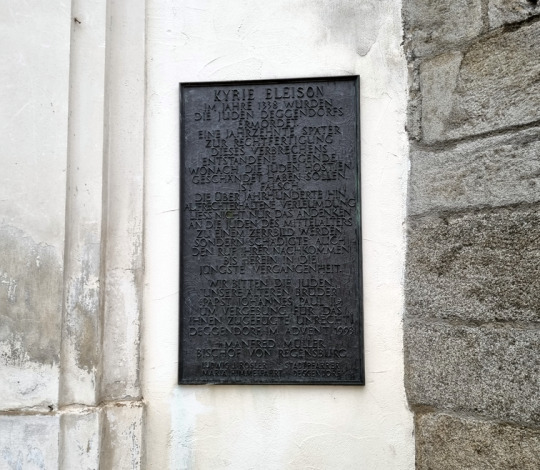
"In 1383 the jews of Deggendorf were killed…the legend that emerged to justify this crime...is false…the slander perpetuated over centuries not only distorted the memory of Jews in the Middle Ages but also harmed the reputation of their descendants into the recent past."
Ehm, ok why? It's internet search and dismayment time! Ahm, how wonderful, this was the place of one of the best covered up vile pogroms in late medieval times in the area! Story time.
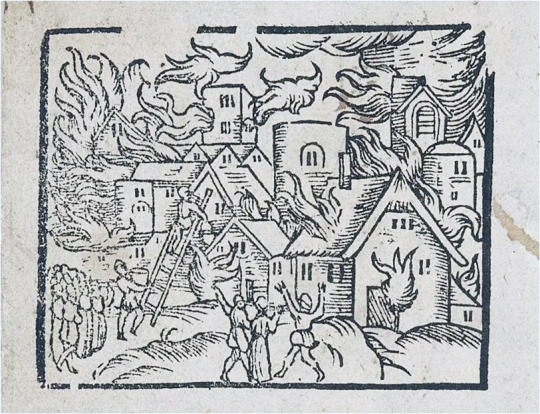
So it happened in 1337 that a large fire broke out, consuming most of the town. Reconstruction was hard, and the needed money came primarily from lenders/bankers, who, by medieval tradition (more like a necessity, as lending was a sin) were the Jewish people. Besides only being able to practise a few crafts to earn a living, these families already had to pay protection money to the king for free practising of their religion ("Reichssteuer"), and were a closed community. Now the whole town was indebted to them.
In the summer of 1338, a plague of locusts destroyed the harvest. Meanwhile, it was thought, the jews of the town lived a good life from their interests. On the eve of September 30, a day before the usual day of next payments, they thought of a good solution: townsfolk surrounded the jewish quarter and looted and murdered everyone in it. And… nothing happened.
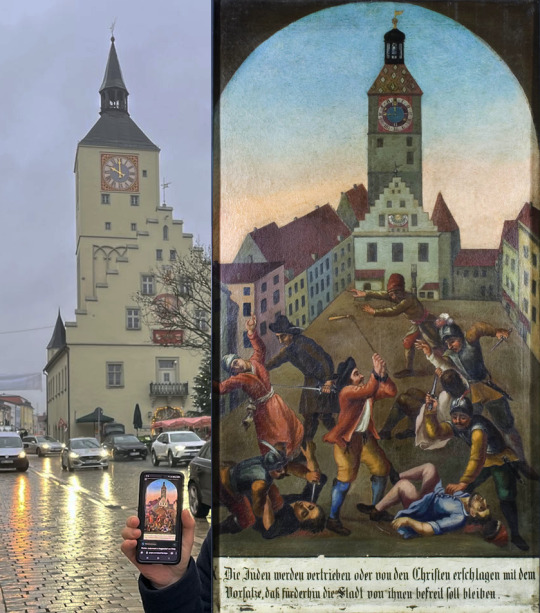
Probably to suppress revolt in an unstable time, Duke Heinrich XIV of Bayern pardoned every participant, and signed a decree allowing "finders keepers" on the belongings and houses (meanwhile divided among themselves) of the massacred. In addition, "the bonds, mortgage deeds, and other documents held by the Jews, or what they should have otherwise repaid to them, shall be completely annulled". To not much surprise, this move resulted in further pogroms and killings in the whole region. However macabre, all that is was still a rather common occurrence in western Europe. What happened in later times makes it stand out.
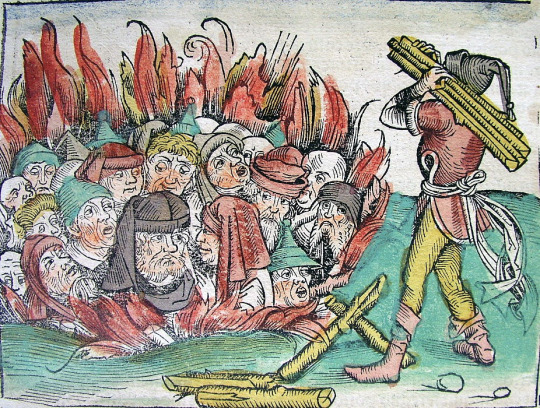
Killing folks - even if "godless pagans" just because you owed them money, getting off for free, and then living in their houses is not such a cool story to tell to your children. Decades after the massacre a new narrative started to emerge. Folk songs and stories started to appear telling another version of the story: the Jews of Deggendorf hatched an evil plan and stole the Sacrilege from the church, trying to smelt it into coins. The Sacrilege cries and bleeds, child Jesus and Virgin Mary appear, alerting the townsfolk, who rush to rescue but a fight and fire breaks out. But the Sacrilege miraculously survives and hovers in the sky (:DD) descending on a monk who immediately becomes a miracle healer, promptly building a temple in the city to safekeep it.

This is the legend of "Deggendorfer Gnad" (Grace/Miracle of Deggendorf). In the following decades, 17 huge oil paintings were made and hung in the church to tell the story in vivid images for every visitor. Pamphlets were printed and distributed, songs being sung, and trinkets sold. The legend of the miracle spread far and wide, and soon Deggendorf became the largest pilgrimage site of the area.

Then there were the "Gnademarkt" market days hosting merchants selling textiles, household items, candles. In 1737 they recorded 140 thousand visitors. The church building and its decorations expanded heavily, featuring now a baroque tower and an expanded altar with vivid sculptures of Jewish figures using their hammers to smash the Sepulture.
As soon as the 18th century Enlightenment, notable politicians and writers lashed out against the festivities and the pilgrimage as being antisemitic, which voices grew louder in the next century. If you expect the story to end with "after the Nazi regime and WWII this festivity also ceased to exist" then, well, no, Deggendorf welcomed tens of thousands of pilgrims throughout the 20th century. The bishops of these decades defended the tradition that it's "part of the Bayern folklore" and harmless, "it doesn't glorify the murder" and "no amount of articles and pamphlets will stop it". To ease up the situation a bit, the church changed the festive theme a bit from miracles "the sins of the pasts, in medieval times to the 20th century" In 1968 bishop Rudolf Graber changed the plan to create a professorship in Judaic Studies in the newly formed University of Regensburg. Instead, he created one in Dogmatic Theology - the position taken by a certain Joseph Ratzinger, if the name rings a bell. This didn't stop researchers to study this story more fully, although with less funding thereon. Church historian Manfred Eder's dissertation in 1992 was the first work that comprehensively revealed the historical background.
Only in the aftermath of this study did the festivities stop for good the next year.
4 notes
·
View notes
Text

In 1957 Barney and Francis began a project to beautify the plant that soon became a tourist attraction. They commissioned Les Grimes, a talented painter of scenic backgrounds for Hollywood movie sets, to create a farm mural on one wall. The result was so inspiring, Les continued to paint the mural until his passing in 1968. Arno Jordan continued the legacy by painting new murals and restoring Grimes' originals.
3 notes
·
View notes
Text

Employment and Activities poster for the Federal Art Project (November 1, 1936.)
"The Federal Art Project (1935–1943) was a New Deal program to fund the visual arts in the United States. Under national director Holger Cahill, it was one of five Federal Project Number One projects sponsored by the Works Progress Administration (WPA), and the largest of the New Deal art projects. It was created not as a cultural activity, but as a relief measure to employ artists and artisans to create murals, easel paintings, sculpture, graphic art, posters, photography, theatre scenic design, and arts and crafts. The WPA Federal Art Project established more than 100 community art centers throughout the country, researched and documented American design, commissioned a significant body of public art without restriction to content or subject matter, and sustained some 10,000 artists and craft workers during the Great Depression." (source)
5 notes
·
View notes
